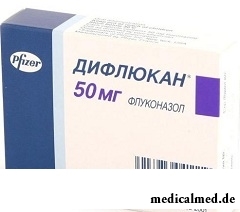





Diflucan
Application instruction:
 Diflucan – antifungal drug.
Diflucan – antifungal drug.
Form of release and structure
Dosage forms of drug:
- Gelatinous solid capsules: have marking of black color in the form of the Pfizer and FLU-50 logo – on capsules No. 4 with a turquoise cover and the white case, "FLU-100" – on capsules No. 2 with a white cover and the case or "FLU-150" – on capsules No. 1 with a cover and the case of turquoise color; in capsules – powder from pale yellow till white color (the capsule No. 4 and No. 2 on 7 pieces in blisters, in a cardboard pack 1 or 4 blisters; capsules No. 1 on 1 or 4 pieces in blisters, in a cardboard pack 1 blister);
- Powder for preparation of suspension for intake: without visible contaminations, has white or almost white color (on 50 mg (powder with concentration of 10 mg / 1 ml) or on 200 mg (40 mg / 1 ml) in plastic bottles of 5 ml complete with a measured spoon, in a cardboard pack 1 set);
- Solution for intravenous (in/in) introductions: colourless, transparent liquid (on 25, 50, 100 or 200 ml in bottles from colourless glass, in a cardboard pack 1 bottle).
Active agent of each of dosage forms of Diflucan – флуконазол:
- 1 capsule – 50 mg (with marking of "FLU-50"), 100 mg ("FLU-100") or 150 mg ("FLU-150");
- 1 ml of ready suspension – 10 mg, 40 mg;
- 1 ml of solution – 2 mg.
Auxiliary components:
- Capsules: starch corn, lactose, silicon dioxide colloid, sodium lauryl sulfate, magnesium stearate;
- Powder: Natrium benzoicum, silicon dioxide colloid anhydrous, gum xanthane, sucrose, titanium dioxide (E171), citrate sodium a dihydrate, fragrance orange (consists of maltodextrin, orange essential oil and water), citric acid anhydrous;
- Solution: sodium chloride, water for injections.
In addition as a part of capsules:
- Case: gelatin, titanium dioxide (E171);
- Lid: gelatin, titanium dioxide (E171), dye blue patent (E131);
- Ink: N-butanol, shellakovy glaze, alcohol industrial metilirovanny 74OP, ferrous oxide black (E172), antifoam DC1510 component, lecithin soy.
Indications to use
- Cryptococcosis, including cryptococcal meningitis, infectious damages of lungs, skin and other bodies at patients with normal immunity, recipients of transplanted organs, at patients with various forms of an immunodeficiency and AIDS; a maintenance therapy at patients AIDS for the purpose of prevention of a recurrence of a cryptococcosis;
- Generalized candidiasis, including the disseminated candidiasis, a kandidemiya, invasive candidosis infections of eyes, peritoneums, an endocardium, uric and respiratory tracts, including at the cancer patients who are on an intensive care immunosuppressive and cytotoxic drugs and at patients with other pathologies predisposed to developing of candidiasis;
- Candidosis balanitis, genital candidiasis, vaginal candidiasis – treatment of an acute or recurrent form and prevention of decrease in frequency of a recurrence (3 and more cases a year);
- Candidiasis of mucous membranes of an organism, including an oral cavity, a throat, a gullet, noninvasive bronchopulmonary infections, a kandiduriya, the chronic skin and mucous and atrophic candidiasis of an oral cavity caused by carrying dentures, at patients with the normal and broken immune function; patients have AIDS – prevention of oropharyngeal candidiasis;
- Deep local mycoses (coccidioidomycosis, paracoccidioidomycosis, histoplasmosis and sporotrichosis) at patients with normal immunity;
- Chromophytosis, mycosis (stop, inguinal area, body skin), onychomycosis and skin candidosis infections.
Besides, use of Diflucan is shown to patients with malignant tumors for prevention of a fungal infection against the background of radiation and cytotoxic therapy.
Contraindications
- Concomitant use of a terfenadin against the background of numerous use of a flukonazol in a dose of 400 mg a day and above;
- Co-administration of a tsizaprid;
- Breastfeeding period;
- Hypersensitivity to components of drug and azolny substances with structure, similar to a flukonazol.
It is necessary to avoid use of drug during pregnancy, except for life-threatening severe forms of fungus diseases of mother when the probable advantage of treatment exceeds possible risk for a fruit.
With care appoint Diflucan: at a combination of a flukonazol in a dose less than 400 mg a day with terfenadiny; at development of functional disturbances of indicators of a liver against the background of reception of a flukonazol; the patient with superficial, invasive or system fungal infections at emergence of skin rash during treatment; at pro-arhythmic states at patients with many risk factors, including an organic heart disease, disturbance of electrolytic balance and the accompanying therapy promoting emergence of similar disturbances.
Route of administration and dosage
- Gelatinous solid capsules: accept without chewing, inside;
- Powder for suspension preparation: accept inside, having added 24 ml of water to bottle contents, carefully shaking up before each reception;
- Solution for (in/in) introductions: it is entered by infusion with a speed no more than 10 ml a minute. At appointment patients to whom restriction of liquid and consumption of sodium is shown need to consider the content of 0,9% of solution of sodium of chloride in solution.
The choice of a dosage form, dose of drug and the period of treatment depend on a clinical condition of the patient and these laboratory researches therefore are defined by the doctor individually.
In case of need replacements of one dosage form by another change of dosing is not made.
To patients of advanced age in the absence of a renal failure drug is appointed in an average dose.
Correction of the mode of dosing at repeated use of drug is necessary for patients with a renal failure, the daily dose is defined depending on laboratory indications of clearance of creatinine.
The recommended dosing of Diflucan for adult patients:
- Cryptococcal meningitis and other cryptococcal infections: in the first day of 400 mg (on average), then on 200-400 mg of 1 times a day. Duration of treatment depends on mycologic and clinical effect, at cryptococcal meningitis, usually, makes 6-8 weeks. After primary full course of therapy preventive administration of drug on 200 mg a day by patients AIDS can be continued during the long period;
- Kandidemiya, the disseminated candidiasis and other invasive candidosis infections: in the first day – 400 mg, then on 200 mg a day, increase up to 400 mg a day is in case of need possible;
- The vaginal candidiasis and balanitis caused by Candida: inside once 150 mg. For the purpose of decrease in frequency of a recurrence of vaginal candidiasis it is possible to accept on 150 mg of 1 times in 4 weeks, duration is defined individually, and can make from 16 weeks to 1 year. Single use of drug for patients aged to 18 is also more senior than 60 years without appointment of the doctor it is not recommended;
- Orofaringealny candidiasis: on 50-100 mg of 1 times a day within 7-14 days. At patients AIDS after a full course of therapy for prevention of a recurrence is appointed on 150 mg once a week, the doctor defines the period individually;
- The atrophic candidiasis of an oral cavity caused by carrying dentures: on 50 mg of 1 times a day, a course of treatment – 14 days, therapy is carried out in combination with antiseptic processing of a prosthesis;
- Noninvasive bronchopulmonary infections, esophagitis, kandiduriya, candidiasis of skin and mucous membranes (except genital candidiasis): on 50-100 mg a day within 14-30 days;
- Skin infections, including mycoses of smooth skin, feet, inguinal area and candidosis infections: on 150 mg once a week or 50 mg of 1 times a day, within 2-4 weeks, at mycosis of feet – up to 6 weeks;
- Chromophytosis: on 300 mg once a week within 2-3 weeks or on 50 mg of 1 times a day 2-4 weeks;
- Deep local mycosis: on 200-400 mg a day, duration of therapy is appointed individually, it can make at a coccidioidomycosis – 11-24 months, a paracoccidioidomycosis – from 2 to 17 months, a sporotrichosis – 1-16 months, histoplasmosis – 3-17 months;
- Onychomycosis: on 150 mg once a week. Treatment is continued before full substitution of the infected nail, the repeated growth of nails on fingers of hands usually requires 3-6 months, stop – 6-12 months;
- Prevention of candidiasis: from 50 to 400 mg of 1 times a day, reception it is necessary to begin some days before alleged development of a neutropenia.
The recommended dosing for children:
- Candidiasis of mucous membranes: in the first day – at the rate of 6 mg on 1 kg of weight of the child, further on 3 mg on 1 kg of weight a day;
- Generalized candidiasis and cryptococcal infection: on 6-12 mg on 1 kg of weight a day;
- Prevention of fungal infections: on 3-12 mg on 1 kg of weight a day, the dose depends on degree and duration of a neutropenia.
For children in the first 2 weeks of life drug is appointed with an interval of 72 hours, at the age of 3-4 weeks – 48 hours.
Side effects
Use of Diflucan can cause side effect:
- From cardiovascular system: lengthening of an interval of an electrical systole of heart (QT) on the electrocardiogram, trembling or ventricular fibrillation;
- From a nervous system: taste change, dizziness, headache, spasms;
- From the alimentary system: nausea, vomiting, an abdominal pain, a meteorism, diarrhea, dyspepsia, a hepatotoxic (sometimes with a lethal outcome), an abnormal liver function, a hepatocellular necrosis, jaundice, hepatitis, increase in level of bilirubin, an alkaline phosphatase, serumal level of alaninaminotranspherase (ALT) and aspartate aminotransferase (nuclear heating plant);
- From system of a hemopoiesis: thrombocytopenia, leukopenia (including neutropenia and agranulocytosis);
- Allergic reactions: face edema, Quincke's disease, skin itch, small tortoiseshell and other anaphylactic reactions;
- From a metabolism: a hypopotassemia, increase in a blood plasma of level of triglycerides and cholesterol;
- Dermatological reactions: an alopecia, rash, exfoliative skin pathologies, including a toxic epidermal necrolysis and Stephens-Johnson's syndrome.
Special instructions
The hepatotoxic action of drug has reversible character, after completion of therapy its signs disappear.
In case of clinical symptoms of damage of a liver during therapy, drug should be cancelled.
Women of childbearing age need to use well-tried remedies of contraception during treatment.
If the patient had a rash as side effect of a flukonazol at therapy of a superficial fungal infection, drug is recommended to be cancelled at once, and at treatment of invasive or system fungal infections it is cancelled at emergence of a mnogoformny erythema or violent defeats.
In rare instances drug can become the reason of anaphylactic reaction.
Under careful control it is necessary to carry out a concomitant use of a flukonazol in doses less than 400 mg a day and a terfenadin.
Patients with potentially pro-arhythmic states флуконазол should apply with care.
Patients with heart diseases, a liver and kidneys have to consult with the doctor before drug use.
At vaginal candidiasis improvement of a state usually occurs in 24 hours after reception of 150 mg of drug, but total disappearance of symptoms of a disease requires sometimes several days. If improvement of a state did not occur, it is necessary to see the attending physician.
Use of drug has no significant effect on ability of the patient to manage vehicles.
Medicinal interaction
Simultaneous use of a tsizaprid, terfenadin (at a dose of a flukonazol of 400 mg a day and more) and Diflucan contraindicated in connection with a high probability of undesirable effects from heart.
The combined treatment with terfenadiny at a dose of a flukonazol less than 400 mg a day perhaps at careful control of level of concentration of a terfenadin in a blood plasma.
At a concomitant use with coumarinic anticoagulants the prothrombin time raises, it can lead to development of bleedings from a nose and digestive tract, to hematomas, melenas, a hamaturia.
Drug increases concentration and psychotropic effects of benzodiazepines (short action), this influence is more expressed after reception of capsules and suspension.
At a multiple concomitant use of thiazide diuretics there is an increase in concentration of a flukonazol in a blood plasma, this effect should be considered though he does not demand review of a dose of a flukonazol from patients.
The concomitant use of Diflucan with food, antacids, Cimetidinum does not exert clinically significant impact on absorption of a flukonazol.
Prolonged use of a flukonazol in doses of 200-300 mg does not exert impact on efficiency of the combined peroral contraceptives.
Drug promotes clinically significant increase in level of concentration in blood serum of Phenytoinum, rifabutin, takrolimus, astemizol and other means which metabolism is implemented by isoenzymes of system of P450 cytochrome. In case of need these combinations, patients it is necessary to observe carefully.
Simultaneous use with rifampicin leads to decrease in pharmacokinetic parameters (AUC) and duration of an elimination half-life (T1/2) of a flukonazol.
Diflucan promotes increase in T1/2 of peroral drugs of sulphonylurea (a glipizid, Glibenclamidum, Chlorproramidum and Tolbutamidum). At joint purpose of these means patients with a diabetes mellitus need to consider a possibility of development of a hypoglycemia.
Drug reduces the average speed of plasma clearance of theophylline.
Action of a flukonazol leads to significant increase in AUC of a zidovudine therefore at simultaneous use of these means it is necessary to monitor development of side effects of a zidovudine carefully.
At simultaneous use with cyclosporine it is necessary to monitor the level of its concentration in blood.
Diflucan in the form of solution can be entered into infusional system together with isotonic normal saline solution, 20% glucose solution, Ringer's solution, aminofuziny, Hartmann's solution, chloride potassium solution in glucose, solution of sodium of bicarbonate of 4,2%.
Terms and storage conditions
To store in the place, unavailable to children, at a temperature up to 30 °C. Not to freeze, store ready suspension at a temperature up to 30 °C no more than 14 days.
Period of validity:
- Capsules and solution for in/in introductions – 5 years;
- Powder for suspension preparation – 3 years.
Name of drug
Price
Drugstore
Diflucan solution for инф 2mg/ml 50 ml No. 1, Pfizer
214 rub.
 Network of the Moscow drugstores of IFC
Network of the Moscow drugstores of IFCDiflucan solution for инф 2mg/ml 100 ml No. 1, Pfizer
351 rub.
 Network of the Moscow drugstores of IFC
Network of the Moscow drugstores of IFCDiflucan of a time. for сусп. 50mg/5ml 35 ml, Pfizer
556 rub.
 Network of the Moscow drugstores of IFC
Network of the Moscow drugstores of IFCWas considered earlier that yawning enriches an organism with oxygen. However this opinion was disproved. Scientists proved that yawning, the person cools a brain and improves its working capacity.

Climax - process of fading of reproductive function of an organism in process of its aging. At women the main sign of its approach showing...
Section: Articles about health
More than a half of the married couples which faced prostatitis – leave. The new broadcast "Female View of Prostatitis" will help to learn – whether you have or your relatives problems....
Section: Articles about health
For many spouses the question of planning of a family is one of the main. The problem of the choice of effective and safe contraceptives at the same time comes out on top. Russians still not often resort to operation of a vasectomy extremely popular in the USA, and also in some European and Asian countries. The reason is simple: most of men simply do not possess the complete information about specifics and effects of this procedure. Let's try to meet this lack and to acquaint readers about those...
Section: Articles about health
All of us, unfortunately, should face flu nearly an every year. It would seem, so frequent disease has to be study...
Section: Articles about health
The person, as well as all other beings living on our planet feels weather changing. It is the normal meteosensitivity which is not causing to healthy people of special troubles. Meteodependence, on the contrary, is morbid condition, характеризующимс...
Section: Articles about health
The metabolism at each person proceeds in own way. However between the speed of this process and disposal of excess weight after all all have a dependence. Unfortunately, the people inclined to try on itself numerous "miracle" diets, not always consider this circumstance and with the most resolute intentions begin to eat so that artificially slow down the metabolism instead of to accelerate it. Except quite clear disappointment, incorrectly picked up systems...
Section: Articles about health
The naturopathy sometimes moves as the new direction of medicine, something like fashionable hobby, and there is nothing farther from the truth....
Section: Articles about health
Visit of doctors – business not the most pleasant, and many people do not hurry to undergo necessary planned inspections. Such behavior is extremely thoughtless and improvident. Our health is necessary not only to us: wellbeing of darlings, children, grandsons and престар...
Section: Articles about health
All got used long ago that, having addressed the plastic surgeon, it is possible to modify natural parameters of a figure or to minimize the damages put to appearance with ruthless time. Many people (preferential women) worldwide annually decide on operations such. However there are also much more exotic interventions which are carried out seldom so far and cost expensive very much. We bring the story about the most unusual of them to your attention....
Section: Articles about health
You heard that laughter prolongs life? To establish longevity direct link with sincere fun to researchers yet not удалос...
Section: Articles about health
New year, wedding, birthday, office party – an occasion to drink at the Russian person will always be. How to reduce a negative impact of alcohol by an organism and to avoid a condition of strong intoxication? The most correct council – to refuse the use spirits напитк...
Section: Articles about health
An eye of the person daily experiences considerable strain. The problem of preservation of sight is for many years directly connected with a question of supply of tissues of eye enough oxygen and nutrients. This task is carried out by small vessels – capillaries. For normal functioning of the visual device extremely important that they kept the integrity, but it works well not always. Microtraumas of eye vessels during which there are small hemorrhages it is extraordinary расп...
Section: Articles about health
Residents of big cities quite often have a disease which is known as the syndrome of chronic fatigue (SCF) today. This illness...
Section: Articles about health
According to doctors, more than a half of men of 25-50 years suffer from frustration of the urinogenital sphere, but the minority sees a doctor from them. And in vain - even the insignificant discomfort in the field of generative organs can serve as a symptom of an illness fraught heavy посл...
Section: Articles about health
Ayurveda - the most ancient tselitelsky practice which came to us from India. It represents the doctrine about maintenance of physical, psychological and moral health of the person by means of the complex of procedures including a diet, cleaning of an organism, breathing exercises, massage, and in case of a disease - and medicinal therapy. The healers practicing Ayurveda assign very important part to spices, and at the heart of Ayurvedic drugs, as a rule, there are they. It is considered that spices not of t...
Section: Articles about health
Stroke (acute disorder of cerebral circulation) – one of the most widespread neurologic diseases. Annually in the world...
Section: Articles about health
Small appetite at the child – the complaint which pediatricians should hear practically from each mother. Most often it is carried to the category of children's whims, however the refusal of food in certain cases can be to alarming symptoms therefore it cannot be ignored....
Section: Articles about health
For the person who daily since morning gathers for work it is very important to wake up vigorous and ready by day of work. Actually, each of us experiences difficulties with this, at first sight, simple business from time to time. After night rest exert impact on a condition of an organism the weather which collected for several days fatigue, household and office problems, quality of a dream and many other factors....
Section: Articles about health
Quite large number of people adheres to the principles of vegetarian food. But how to be if in a family of vegetarians is д...
Section: Articles about health
History of mankind contains several tens of epidemics whose emergence was compared by eyewitnesses and historians to doomsday. The most terrible of them claimed the lives of millions of people, having made even the whole people to the person of the earth. What they − the diseases striking terror? Daringly...
Section: Articles about health
The business lady, the become mother, it is necessary to solve an array of problems. But of them is main: how to combine the beloved child and work? What traps trap the working mother and how she needs to behave?...
Section: Slideshow
Radiological methods of a research are applied in medicine more than hundred years, and thanks to them millions of lives were saved. In m...
Section: Articles about health
Practice of hypnotic impact on consciousness of the person contains about two millennia. During this time scientists managed to learn a lot of things about a phenomenon of hypnosis and learned to facilitate a condition of the patients having heavy illnesses with its help....
Section: Articles about health
The climax, or menopause is the normal process of the termination of genital function of the woman which is followed by serious hormonal changes in an organism. Usually the menopause begins at the age of 50-55 years, but characteristics of this process are very individual. Factors of earlier approach of a climax are irregular sex life, numerous abortions, addictions, existence of endocrine, autoimmune and gynecologic diseases, frequent stresses and excessive hobby of diets...
Section: Articles about health
Cellulitis - very widespread cosmetic shortcoming which arises approximately at 80% of women sooner or later. Emergence ег...
Section: Articles about health
Dietary supplements (dietary supplements) for the last decades were so thoroughly included into our life that, apparently, it is already impossible to find the person who at least once did not try them. At the same time, most of our compatriots have a vague idea about...
Section: Articles about health
According to World Health Organization, every third inhabitant of Earth has excess weight, and every tenth has obesity. The reason of this phenomenon, according to specialists, roots in one not very comforting fact: most of people consume much more calories, than it is necessary. How it turns out what we overeat? Why it is so difficult to refuse an excess portion tasty or additives? Let's try to find out what factors prevent us to eat food with reasonable moderation....
Section: Articles about health

